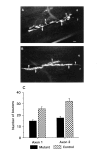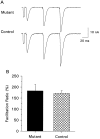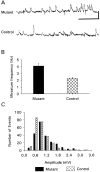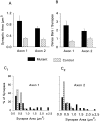Homeostasis of synaptic transmission in Drosophila with genetically altered nerve terminal morphology
- PMID: 8656281
- PMCID: PMC6578607
- DOI: 10.1523/JNEUROSCI.16-12-03877.1996
Homeostasis of synaptic transmission in Drosophila with genetically altered nerve terminal morphology
Abstract
We present a new test of the hypothesis that synaptic strength is directly related to nerve terminal morphology through analysis of synaptic transmission at Drosophila neuromuscular junctions with a genetically reduced number of nerve terminal varicosities. Synaptic transmission would decrease in target cells with fewer varicosities if there is a relationship between the number of varicosities and the strength of synaptic transmission. Animals that have an extreme hypomorphic allele of the gene for the cell adhesion molecule Fasciclin II possess fewer synapse-bearing nerve terminal varicosities; nevertheless, synaptic strength is maintained at a normal level for the muscle cell as a whole. Fewer failures of neurotransmitter release and larger excitatory junction potentials from individual varicosities, as well as more frequent spontaneous release and larger quantal units, provide evidence for enhancement of transmitter release from varicosities in the mutant. Ultrastructural analysis reveals that mutant nerve terminals have bigger synapses with more active zones per synapse, indicating that synaptic enlargement and an accompanying increase in synaptic complexity provide for more transmitter release at mutant varicosities. These results show that morphological parameters of transmitting nerve terminals can be adjusted to functionally compensate for genetic perturbations, thereby maintaining optimal synaptic transmission.
Figures









Similar articles
-
Synaptic ultrastructure in nerve terminals of Drosophila larvae overexpressing the learning gene dunce.J Neurobiol. 2000 Apr;43(1):89-97. doi: 10.1002/(sici)1097-4695(200004)43:1<89::aid-neu8>3.0.co;2-l. J Neurobiol. 2000. PMID: 10756069
-
Structural Remodeling of Active Zones Is Associated with Synaptic Homeostasis.J Neurosci. 2020 Apr 1;40(14):2817-2827. doi: 10.1523/JNEUROSCI.2002-19.2020. Epub 2020 Mar 2. J Neurosci. 2020. PMID: 32122953 Free PMC article.
-
Altered nerve terminal arborization and synaptic transmission in Drosophila mutants of cell adhesion molecule fasciclin I.J Neurosci. 1995 Oct;15(10):6679-87. doi: 10.1523/JNEUROSCI.15-10-06679.1995. J Neurosci. 1995. PMID: 7472428 Free PMC article.
-
Diversification of synaptic strength: presynaptic elements.Nat Rev Neurosci. 2002 Jul;3(7):497-516. doi: 10.1038/nrn876. Nat Rev Neurosci. 2002. PMID: 12094207 Review.
-
Invaginating Presynaptic Terminals in Neuromuscular Junctions, Photoreceptor Terminals, and Other Synapses of Animals.Neuromolecular Med. 2017 Sep;19(2-3):193-240. doi: 10.1007/s12017-017-8445-y. Epub 2017 Jun 13. Neuromolecular Med. 2017. PMID: 28612182 Free PMC article. Review.
Cited by
-
Analysis of various physiological salines for heart rate, CNS function, and synaptic transmission at neuromuscular junctions in Drosophila melanogaster larvae.J Comp Physiol A Neuroethol Sens Neural Behav Physiol. 2014 Jan;200(1):83-92. doi: 10.1007/s00359-013-0864-0. Epub 2013 Nov 5. J Comp Physiol A Neuroethol Sens Neural Behav Physiol. 2014. PMID: 24190421
-
Quantal size and variation determined by vesicle size in normal and mutant Drosophila glutamatergic synapses.J Neurosci. 2002 Dec 1;22(23):10267-76. doi: 10.1523/JNEUROSCI.22-23-10267.2002. J Neurosci. 2002. PMID: 12451127 Free PMC article.
-
GABA transporters in Drosophila melanogaster: molecular cloning, behavior, and physiology.Invert Neurosci. 1998 Mar;3(4):279-94. doi: 10.1007/BF02577688. Invert Neurosci. 1998. PMID: 10212397
-
TDP-43 regulates Drosophila neuromuscular junctions growth by modulating Futsch/MAP1B levels and synaptic microtubules organization.PLoS One. 2011 Mar 11;6(3):e17808. doi: 10.1371/journal.pone.0017808. PLoS One. 2011. PMID: 21412434 Free PMC article.
-
Binding of serotonin to receptors at multiple sites is required for structural plasticity accompanying long-term facilitation of Aplysia sensorimotor synapses.J Neurosci. 1998 Jun 1;18(11):3991-4000. doi: 10.1523/JNEUROSCI.18-11-03991.1998. J Neurosci. 1998. PMID: 9592080 Free PMC article.
References
-
- Atwood HL, Govind CK, Wu C-F. Differential ultrastructure of synaptic terminals on ventral longitudinal abdominal muscles in Drosophila larvae. J Neurobiol. 1993;24:1008–1024. - PubMed
-
- Bailey CH, Kandel ER. Structural changes accompanying memory storage. Annu Rev Physiol. 1993;55:397–426. - PubMed
-
- Connor EA, Smith MA. Retrograde signalling in the formation and maintenance of the neuromuscular junction. J Neurobiol. 1994;25:722–739. - PubMed
Publication types
MeSH terms
Substances
LinkOut - more resources
Full Text Sources
Molecular Biology Databases
